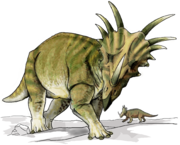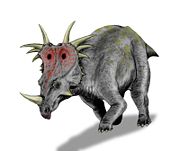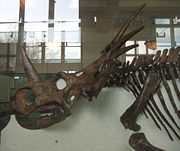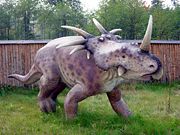Styracosaurus
2008/9 Schools Wikipedia Selection. Related subjects: Dinosaurs
| Styracosaurus Fossil range: Late Cretaceous |
||||||||||||||||||||
|---|---|---|---|---|---|---|---|---|---|---|---|---|---|---|---|---|---|---|---|---|
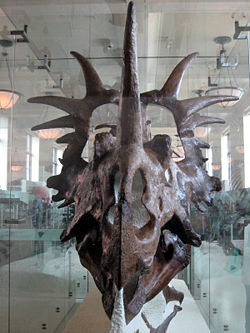 Styracosaurus albertensis skull, American Museum of Natural History.
|
||||||||||||||||||||
| Scientific classification | ||||||||||||||||||||
|
||||||||||||||||||||
| Species | ||||||||||||||||||||
|
Styracosaurus (pronounced /stɪˌrækəˈsɔrəs/, meaning "spiked lizard" from Greek styrax/στυραξ 'spike at the butt-end of a spear-shaft' and saurus/σαυρος 'lizard') was a genus of herbivorous ceratopsian dinosaur from the Cretaceous Period ( Campanian stage), about 76.5 to 75.0 million years ago. It had four to six long horns extending from its neck frill, a smaller horn on each of its cheeks, and a single horn protruding from its nose, which may have reached dimensions of around 60 centimeters (2 ft) long and 15 centimeters (6 in) wide. The function or functions of the horns and frills have been the subject of debate for many years.
Styracosaurus was a large dinosaur, reaching lengths of 5.5 meters (18 ft) and weighing nearly 3 tons. It stood about 1.8 meters (6 ft) tall. Styracosaurus possessed four short legs and a bulky body. Its tail was rather short. It also had a beak and flat cheek teeth, indicating that its diet was herbivorous. Like other ceratopsians, this dinosaur may have been a herd animal, traveling in large groups, as suggested by bonebeds.
Named by Lawrence Lambe in 1913, Styracosaurus is a member of the Centrosaurinae. Two species, S. albertensis and S. ovatus are currently assigned to Styracosaurus. Other species assigned to the genus have since been reassigned elsewhere.
Description
Individuals of the Styracosaurus genus were approximately 5.5 m (18 ft) long as adults and weighed around 2.7 tons. The skull was massive, with a large nostril, a tall straight nose horn, and a parietosquasomal frill (a neck frill) crowned with at least four large spikes. Each of the four longest frill spines was comparable in length to the nose horn, at 50 to 55 centimeters long (19.7 to 21.7 in). The nasal horn is estimated at 57 centimeters long (19.7 in) in the type specimen, but the horn is only partially complete. Based on other nasal horn cores from Styracosaurus and Centrosaurus, this horn may have come to a rounded point at around half of that length.
Aside from the large nasal horn and four long frill spikes, the cranial ornamentation was variable. Some individuals had small hook-like projections and knobs at the posterior margin of the frill, similar to but smaller than those in Centrosaurus. Others had less prominent tabs. Some, like the type individual, had a third pair of long frill spikes. Others had much smaller projections. Second species S. ovatus had only four large spikes, but the inner pair curved toward each other, the opposite of what is seen in the much better known S. albertensis. Other small points are found on the side margins of some but not all specimens. Modest pyramid-shaped brow horns were present in subadults, but were replaced by pits in adults. Like most ceratopsids, Styracosaurus had large fenestrae (skull openings) in its frill. The front of the mouth had a toothless beak.
The bulky body of Styracosaurus resembled that of a rhinoceros. It had powerful shoulders which may have been useful in intraspecies combat. Styracosaurus had a relatively short tail. Each toe bore a hooflike ungual which was sheathed in horn.
Various limb positions have been proposed for Styracosaurus and ceratopsids in general, including forelegs which were held underneath the body, or, alternately, held in a sprawling position. The most recent work has put forward an intermediate crouched position as most likely. Paleontologists Gregory Paul and Per Christiansen of the Zoological Museum of the University of Copenhagen in Denmark proposed that large ceratopsians such as Styracosaurus were able to run at speeds exceeding that of an elephant, based on possible ceratopsian trackways which did not exhibit signs of sprawling forelimbs.
Classification
Styracosaurus is a member of the Centrosaurinae, a subfamily of large North American horned dinosaurs characterized by their "prominent nasal horns, subordinate brow horns, short squamosals in a short frill, a tall, deep face relative to the ceratopines, and a projection into the rear of the nasal fenestra." Other members of the clade include Centrosaurus (from which the group takes its name), Pachyrhinosaurus, Avaceratops, Einiosaurus, Albertaceratops, Achelousaurus, Brachyceratops, and Monoclonius, although these last two are dubious. Because of the variation between species and even individual specimens of centrosaurines, there has been much debate over which genera and species are valid, particularly whether Centrosaurus and/or Monoclonius are valid genera, undiagnosable, or possibly members of the opposite sex. In 1996, Peter Dodson found enough variation between Centrosaurus, Styracosaurus, and Monoclonius to warrant separate genera, and that Styracosaurus resembled Centrosaurus more closely than either resembled Monoclonius. Dodson also believed one species of Monoclonius, M. nasicornis, may actually have been a female Styracosaurus. His assessments have been partially followed, with other researchers not accepting Monoclonius nasicornis as a female Styracosaurus, or Monoclonius as a valid genus. While sexual dimorphism has been proposed for an earlier ceratopsian Protoceratops, there is no firm evidence for sexual dimorphism in any ceratopsids.
Origins
The evolutionary origins of Styracosaurus were not understood for many years because fossil evidence for early ceratopsians was sparse. The discovery of Protoceratops, in 1922, shed light on early ceratopsid relationships, but several decades passed before additional finds filled in more of the blanks. Fresh discoveries in the late 1990s and 2000s, including Zuniceratops, the earliest known ceratopsian with brow horns, and Yinlong, the first known Jurassic ceratopsian, indicate what dinosaurs related to the ancestors of Styracosaurus may have looked like. These new discoveries have been important in illustrating the origins of horned dinosaurs in general, and suggest that the group originated during the Jurassic in Asia, and the appearance of truly horned ceratopsians by the beginning of the late Cretaceous in North America.
Discoveries and species
The first fossil remains of Styracosaurus were collected in Alberta, Canada by C.M. Sternberg (from an area now known as the Dinosaur Provincial Park, in a formation now called the Dinosaur Park Formation) and named by Lawrence Lambe in 1913. This quarry was revisited in 1935 by a Royal Ontario Museum crew who found the missing lower jaws and most of the skeleton. These fossils indicate that S. albertensis was around 5.5 to 5.8 meters in length and stood about 1.65 meters high at the hips. An unusual feature of this first skull is that the smallest frill spike on the left side is partially overlapped at its base by the next spike. It appears that the frill suffered a break at this point in life and was shortened by about 6 centimeters (2 in). The correct shape of this area is unknown because the corresponding area of the right side of the frill was not recovered.
Barnum Brown and Erich Maren Schlaikjer, working for the American Museum of Natural History in New York, collected a nearly complete articulated skeleton with a partial skull in 1915. These fossils were also found in the Dinosaur Park Formation, near Steveville, Alberta. Brown and Schlaikjer compared the finds, and, though they allowed that both specimens were from the same general locality and geological formation, they considered the specimen sufficiently distinct from the holotype to warrant erecting a new species, and described the fossils as Styracosaurus parksi, named in honour of William Parks. Among the differences between the specimens cited by Brown and Schlaikjer were a cheekbone quite different from that of S. albertensis, and smaller tail vertebrae. S. parksi also had a more robust jaw, a shorter dentary, and the frill differed in shape from that of the type species. However, much of the skull consisted of plaster reconstruction, and the original 1937 paper did not illustrate the actual skull bones. It is now accepted as a specimen of S. albertensis.
In the summer of 2006, Darren Tanke of the Royal Tyrrell Museum of Palaeontology in Drumheller, Alberta relocated the long lost S. parksi site. Pieces of the skull, evidently abandoned by the 1915 crew, were found in the quarry. These were collected and it is hoped more pieces will be found, perhaps enough to warrant a redescription of the skull and test whether S. albertensis and S. parksi are the same. The Tyrrell Museum has also collected several partial Styracosaurus skulls. At least one confirmed bonebed (bonebed 42) in Dinosaur Provincial Park has also been explored (other proposed Styracosaurus bonebeds instead have fossils from a mix of animals, and nondiagnostic ceratopsian remains). Bonebed 42 is known to contain numerous pieces of skulls such as horncores, jaws and frill pieces.
A third species, S. ovatus, from the Two Medicine Formation of Montana, was described by Gilmore in 1930. The fossil material is limited, with the best being a portion of the parietal bone of the frill, but one unusual feature is that the pair of spikes closest to the midline converge towards the midline, rather than away from it as in S. albertensis. There also may only have been two sets of spikes on each side of the frill, instead of three. The spikes are much shorter than in S. albertensis, with the longest only 295 millimeters (11.6 in) long. Recent review of styracosaur skull remains by Ryan, Holmes, and Russell finds it to be a distinct species.
Several other species which were assigned to Styracosaurus have since been assigned to other genera. S. sphenocerus, described by Edward Drinker Cope in 1890 as a species of Monoclonius and based on a nasal bone with a broken Styracosaurus-like straight nose horn, was attributed to Styracosaurus in 1915. "S. makeli", mentioned informally by amateur paleontologists Stephen and Sylvia Czerkas in 1990 in a caption to an illustration, is an early name for Einiosaurus. "S. borealis" is an early informal name for S. parksi.
Paleobiology
Styracosaurus and other horned dinosaurs are often depicted in popular culture as herding animals. A bonebed composed of Styracosaurus remains is known from the Dinosaur Park Formation of Alberta, about halfway up the formation. This bonebed is associated with different types of river deposits. The mass deaths may have been a result of otherwise non-herding animals congregating around a waterhole in a period of drought, with evidence suggesting the environment may have been seasonal and semiarid.
Styracosaurus is known from higher in the formation than the closely-related Centrosaurus, suggesting that Styracosaurus displaced Centrosaurus as the environment changed over time.
Dentition and diet
Styracosaurus were herbivorous dinosaurs; they probably fed mostly on low growth because of the head's position. They may, however, have been able to knock down taller plants with their horns, beak, and bulk. The jaws were tipped with a deep, narrow beak, believed to have been better at grasping and plucking than biting.
Ceratopsid teeth, including those of Styracosaurus, were arranged in groups called batteries. Older teeth on top were continually replaced by the teeth underneath them; this occurred throughout the life of the animal. Unlike hadrosaurids, which also had dental batteries, ceratopsid teeth sliced but did not grind. Some scientists have suggested ceratopsids like Styracosaurus ate palms and cycads, while others have suggested ferns. Dodson has proposed that Late Cretaceous ceratopsians may have knocked down angiosperm trees and then sheared off leaves and twigs.
Horns and frill
The large nasal horns and frills of Styracosaurus are among the most distinctive facial adornments of all dinosaurs. Their function has been the subject of debate ever since the first horned dinosaurs were discovered.
Early in the 20th century, paleontologist R. S. Lull put forth the hypothesis that the frills of ceratopsian dinosaurs acted as anchor points for their jaw muscles. He later noted that for Styracosaurus, the spikes would have given it a formidable appearance. In 1996, Dodson supported the idea of muscle attachments in part and created detailed diagrams of possible muscle attachments in the frills of Styracosaurus and Chasmosaurus, but did not subscribe to the idea that they completely filled in the fenestrae. C.A. Forster, however, found no evidence of large muscle attachments on the frill bones.
It was long believed ceratopsians like Styracosaurus used their frills and horns in defence against the large predatory dinosaurs of the time. Although pitting, holes, lesions, and other damage on ceratopsid skulls are often attributed to horn damage in combat, a 2006 study found no evidence for horn thrust injuries causing these forms of damage (for example, there is no evidence of infection or healing). Instead, non-pathological bone resorption, or unknown bone diseases, are suggested as causes.
The large frill on Styracosaurus and related genera also may have helped to increase body area to regulate body temperature, like the ears of the modern elephant. A similar theory has been proposed regarding the plates of Stegosaurus, although this use alone would not account for the bizarre and extravagant variation seen in different members of the Ceratopsidae. This observation is highly suggestive of what is now believed to be the primary function, display.
The theory of frill use in sexual display was first proposed in 1961 by Davitashvili. This theory has gained increasing acceptance. Evidence that visual display was important, either in courtship or in other social behavior, can be seen in the fact that horned dinosaurs differ markedly in their adornments, making each species highly distinctive. Also, modern living creatures with such displays of horns and adornments use them in similar behaviour.
In popular culture
Because of the distinctive frill and horns of Styracosaurus, depictions of these animals are easily recognizable. The spines, hooks, and horns attached to the head of this dinosaur sparked the imagination of filmmakers during the earliest days of motion pictures, and this has led to its appearance in films ever since. Notable among them are: The Son of Kong (1933), where a Styracosaurus battles the movie's heroes; The Valley of Gwangi (1969), where Styracosaurus is pitted against a carnivorous dinosaur; and Disney's CGI film Dinosaur (2000), where an anthropomorphic Styracosaurus named Eema has a pet Ankylosaurus. The genus also appeared in the novel of Jurassic Park, in the list of dinosaurs present in the park, but was not seen in the film adaptation.
On the small screen, Styracosaurus has appeared in many cartoons and anime, including Power Rangers: Dino Thunder ( Bakuryuu Sentai Abaranger), Dinozaurs, Dino-Riders, Dinosaucers, and Zoids. Styracosaurus has also been featured in various video games, including the popular Jurassic Park, Turok, and Zoo Tycoon game franchises. It was also a huntable dinosaur in the dinosaur hunting game Primal Prey.
Styracosaurus has appeared in some dinosaur scale model lines, such as the Carnegie Collection.

